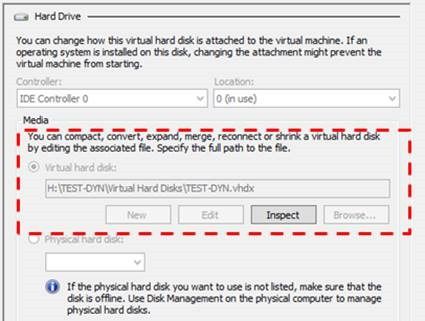~ Chuck Timon | Senior Support Escalation Engineer

A customer uses System Center 2012 R2 Virtual Machine Manager (VMM 2012 R2) to manage standalone Hyper-V servers. The servers are configured with Dynamic Disks formatted with NTFS partitions. The Dynamic Disks host virtual machine files, and drive letters and volume labels are assigned. Here is an example:

Before I go further, I want to be clear that I mean 'Dynamic Disks' in the context of a Host and not a virtual machine. For those who need a quick refresher, please see the following:
The primary problem in this case involves the path to the destination storage for the virtual machine files. If a virtual machine is created locally on the Hyper-V server itself, a drive letter (associated with the path to the local storage) is available when selecting a destination for the virtual machine files and is reflected in the configuration after the virtual machine is created.

When deploying a virtual machine to the same Host using VMM, a drive letter is not available in the wizard. Instead, a volume GUID with a label is presented as a selection to the user.

After the deployment completes, an inspection of the virtual machine properties shows the path with the volume GUID:

Does it work? Yes it does. As you can see here, I have two virtual machines hosted on this Dynamic Disk ( Test-DYN and Test-DYN-2 ), one created in Hyper-V and the other in VMM, and they are functioning properly.

The concern from the customer perspective is that it is an inconvenience having to remember GUIDs, and not having a drive letter (in the VMM UI only) could cause confusion for their users. However, implementing meaningful labels for these Dynamic Disks could help resolve a lot of the confusion.
The bottom line is that Dynamic Disks are rarely used in a virtualization environment to host virtual machine files, and they are being deprecated going forward. Therefore, at some point in the future, they will no longer be relevant. Nevertheless, this will be brought to the attention of our Product Team.
Note: This issue is also applicable in System Center 2012 Virtual Machine Manager Service Pack 1 (SP1).
Thanks, and come back again soon!
Chuck Timon | Senior Support Escalation Engineer | Microsoft Enterprise Platforms Support
Get the latest System Center news on Facebook and Twitter :


System Center All Up: http://blogs.technet.com/b/systemcenter/
Configuration Manager Support Team blog:
http://blogs.technet.com/configurationmgr/
Data Protection Manager Team blog:
http://blogs.technet.com/dpm/
Orchestrator Support Team blog:
http://blogs.technet.com/b/orchestrator/
Operations Manager Team blog:
http://blogs.technet.com/momteam/
Service Manager Team blog:
http://blogs.technet.com/b/servicemanager
Virtual Machine Manager Team blog:
http://blogs.technet.com/scvmm
WSUS Support Team blog: http://blogs.technet.com/sus/
The RMS blog: http://blogs.technet.com/b/rms/
App-V Team blog: http://blogs.technet.com/appv/
MED-V Team blog: http://blogs.technet.com/medv/
Server App-V Team blog: http://blogs.technet.com/b/serverappv
The Surface Team blog: http://blogs.technet.com/b/surface/
The Application Proxy blog: http://blogs.technet.com/b/applicationproxyblog/
The Forefront Endpoint Protection blog :
http://blogs.technet.com/b/clientsecurity/
The Forefront Identity Manager blog :
http://blogs.msdn.com/b/ms-identity-support/
The Forefront TMG blog:
http://blogs.technet.com/b/isablog/
The Forefront UAG blog:
http://blogs.technet.com/b/edgeaccessblog/
SCVMM 2012 R2